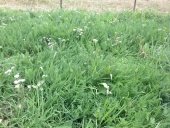
 2
2












Seed the Mind, Harvest Ideas.
http://farmwhisperer.com




Moderator, Treatment Free Beekeepers group on Facebook.
https://www.facebook.com/groups/treatmentfreebeekeepers/









It's never too late to start! I retired to homestead on the slopes of Mauna Loa, an active volcano. I relate snippets of my endeavor on my blog : www.kaufarmer.blogspot.com
 1
1














It's never too late to start! I retired to homestead on the slopes of Mauna Loa, an active volcano. I relate snippets of my endeavor on my blog : www.kaufarmer.blogspot.com
 1
1




How permies.com works
What is a Mother Tree ?


























'Science is the father of knowledge, but opinion breeds ignorance.' - Hippocrates




Life is too short, plant a tree for those that follow.




John Fajer wrote:1. How large is your compost pile?
John Fajer wrote:2. How often, if ever, do you water your compost pile?
John Fajer wrote:3. How frequently do you turn your compost pile?




Freakin' hippies and Squares, since 1986




Ryan Harp
Kansas City discussion going on here!
Kansas City Homesteaders








John Fajer wrote:
1. How large is your compost pile?
2. How often, if ever, do you water your compost pile?
3. How frequently do you turn your compost pile?












Subtropical desert (Köppen: BWh)
Elevation: 1090 ft Annual rainfall: 7"
 1
1








Susan Jensen wrote:
John Fajer wrote:
1. How large is your compost pile?
2. How often, if ever, do you water your compost pile?
3. How frequently do you turn your compost pile?
Hello, interesting to see what everyone is doing. I raise chickens, worms, and garden on my suburban lot, so composting is a big part of the process:
1. I have:
- a 3 ft x 3 ft pile and an Earth Machine composter for chicken manure
- a 3 foot by 5 foot wooden box for garden and yard clippings
- a Worm Factory, a Rubbermaid worm bin, and a box made from a treestump for kitchen scraps.
There are photos on my worm composting website here: Worm Composting Bins
2. I water the open pile about once a month but only in the summer. The challenge in my climate is usually to keep it dry.
3. I turn the open pile about every 3 months. There are few worms in the chicken manure since it is strong. But in the other bins, I have red wiggler worms doing the turning.
 1
1




 1
1




Pics and text about my fermentation adventures: http://brewathonlite.blogspot.com

 1
1




John Fajer wrote:1. How large is your compost pile?
2. How often, if ever, do you water your compost pile?
3. How frequently do you turn your compost pile?
QuickBooks set up and Bookkeeping for Small Businesses and Farms - jocelyncampbell.com
 2
2




Dr. Denice Moffat & Michael Robison
www.NaturalHealthTechniques.com or
http://www.facebook.com/pages/Elk-Meadow-Farm-Nursery/209184999104914










|
I don't like that guy. The tiny ad agrees with me.
The new gardening playing cards kickstarter is now live!
https://www.kickstarter.com/projects/paulwheaton/garden-cards
|




